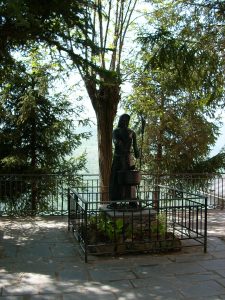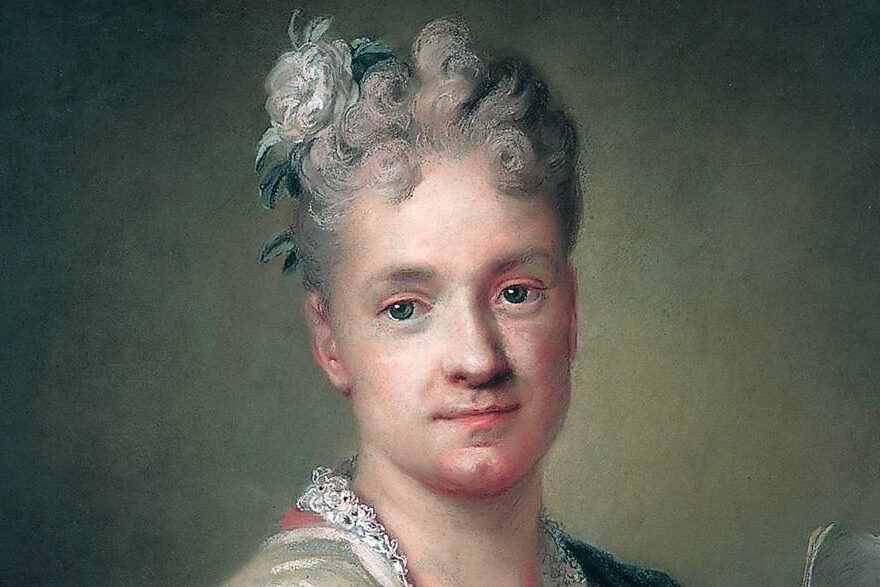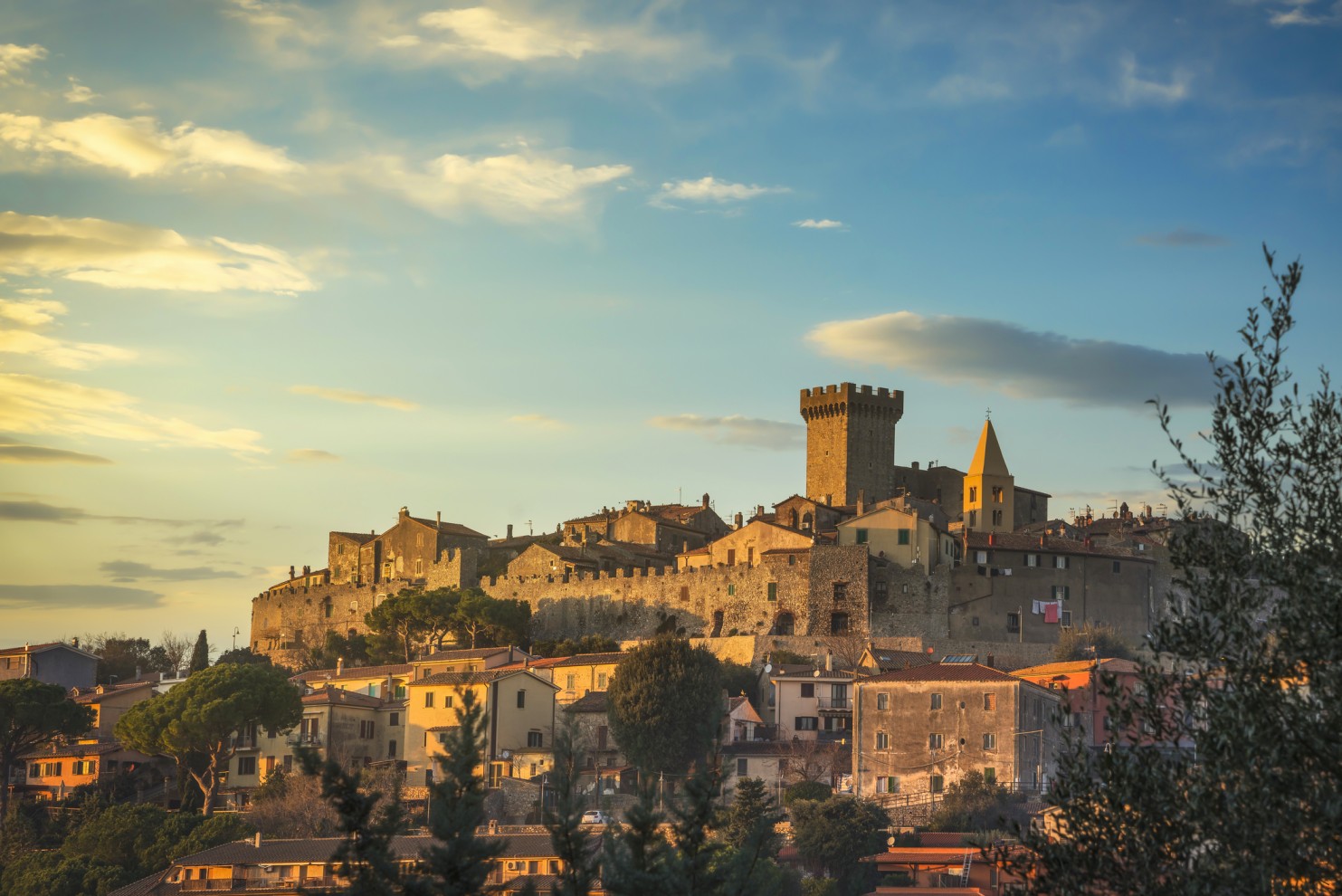I brought with me a little sachet of salt, a time-honored remedy to ward off evil spirits, when visiting two Medieval borghi on La Riviera dei Fiori whose history includes a bizarre story of witchcraft, envy, superstition and power.
The first, Triora, which means “Three Mouths”, is scattered across the scenic interior in the Alta Val Argentina at 900 meters in altitude. Close by is Dolceacqua, or “Sweet Water”, a well-preserved town with a peaceful atmosphere just 10 km from the French Riviera. Both are in the mountainous province of Imperia.
They are two distinct places, but they have in common a somber past shrouded in mystery.
Beautiful but quasi-abandoned Triora counts just 400 souls. It is nested in the mountains, seemingly still in the foreboding shadow of witch trials held in 1588 when it was an important fortress in the Republic of Genoa.
Site of one of the largest witch trials in Italian history, it was rumored to be a haven for witchcraft as widespread crop failures led to famine. Starving locals were convinced witchcraft was the cause.
“Dozens of women were interrogated and imprisoned,” says Professor Paolo Portone, curator of a new witchcraft museum (Museo della Stregoneria) that opened last December at Palazzo Stella, a restored building that housed the trial in 1588. A work in progress, the museum has a collection of paraphernalia such as black crucifixes and caldrons.
“A section of the museum focuses on documents from the trials,” he says.
The Inquisitor of Genoa verified local suspicions and 20 women were rounded up after parishioners at a mass pointed fingers at them. The number of alleged witches increased as the women were forced under torture to name accomplices. At least four were burned at the stake.
“Most of the women were not executed at the end of the trials, which today provide a case study of how the Catholic Church changed its attitude toward the crime known as “diabolical witchcraft” because in the late 16th century a new priority emerged — stopping the spread of Lutheran ideas,” he says.
Historians note that thousands of so-called witches killed in Europe between 1500 and 1700 were healers. “The witches of Triora were healers as well,” says Portone. “They were dominae herbarum, gifted herbalists that were competitors to medical doctors and priests as well. They attracted jealousy, producing hysteria.”
Triora boasts the impressive San Bernardino church that displays a 15th century fresco depicting witches.
If you visit Triora, take the time to check out picturesque Dolceacqua in the Nervia Valley, where the persecution of diabolical witchcraft was also active. “The valley was lashed by a fevered wave of witch hunts,” says Andrea Scibilia, founder and artistic director at Autunnonero, a cultural association that promotes folklore as a way to discover Liguria’s heritage.
“Secret Inquisition emissaries held a tribunal here,” he says. “They started hearings and tortured women accused of heresy and witchcraft. We know only the names of most of them. But we do know the entire stories of Girolima Sappia and Maria Aicardi.
“Girolima learned herbal cures from her mother,” Andrea explains. “They interrogated her for days. On July 25, 1636, she was shackled in the piazza. People she had cured insulted her and mocked her.”
What about Maria? “Called to reveal other witches and the place where they met for the Sabbath, she was accused of killing a child on Christmas Day to offer him to the devil,” says Andrea. “On May 2, 1639, Maria was tied to a rope. She was lifted high off the ground, crying out her innocence. They inflicted maximum pain, then she was imprisoned. Nobody heard from her after,” Andrea continues.
Those stories and many others are told during a unique ghost tour that Autunnonero creates at any time of the year in Acquadolce. Its storytellers (
www.autunnonero.com) connect the audience to the Dolceacqua world of the time through reenactments.
You can delight in the beauty of the Medieval town and its Roman bridge that gives such a sense of lightness it inspired the painter Monet.
Afterward, a perfect place to relax is the L’Agriturismo La Vecchia (
www.lavecchiadolceacqua.it), a country hotel with six comfortable, stylish rooms. Each is colorfully refurbished with hand-painted wardrobes, tables and drawers. La Vecchia is in the heart of the city, offering a tranquil, relaxed base just 5 km from the sea. The restaurant brings you through a magic gastronomical journey of Ligurian dishes. Enjoy delicious food, olive oil and the Rossese wine.
Everything is produced nearby, and owner Gianni’s enthusiasm for his dogs’ friendly rustic haven is intoxicating.
Acquadolce is dominated by the ruins of Doria castle, where the cruel 14th century lord of the manor Imperiale Doria is said to have used the custom ius primaes noctis, the right to the virginity of his peasants’ brides on the first night.
“He locked a woman named Lucrezia inside his castle,” Scibilia explains “When she rejected him, he exploded with fury. She was beaten and died of thirst. They say that her ghost still roams the haunted castle, where her lamentations can still be heard.”
Ho portato con me un sacchettino di sale, un rimedio radicato nel tempo per tenere lontani gli spiriti maligni, quando ho visitato due borghi medievali sulla Riviera dei Fiori la cui storia comprende una bizzarra storia di stregoneria, invidia, superstizione e potere.
Il primo, Triora, che significa “Tre Bocche”, è disseminato nelle scenografiche valli dell’Alta Val Argentina a 900 metri di altitudine. Vicino c’è Dolceacqua, una città ben conservata con un’atmosfera tranquilla a soli 10 km dalla riviera francese. Entrambi sono nella provincia montuosa di Imperia.
Sono due luoghi distinti, ma hanno in comune un tetro passato avvolto nel mistero.
Bella ma quasi abbandonata, Triora conta solo 400 anime. È annidata nelle montagne, apparentemente ancora avvolta nell’ombra inquietante dei processi alle streghe del 1588, quando era una importante fortezza della Repubblica di Genova.
Sito di uno dei più grandi studi della stregoneria della storia italiana, si diceva fosse un paradiso per la stregoneria, visto che i diffusi fallimenti della coltivazione avevano portato alla carestia. La gente del posto, affamata, era convinta che la stregoneria ne fosse la causa.
“Dozzine di donne furono interrogate e imprigionate”, afferma il professor Paolo Portone, curatore del nuovo Museo della Stregoneria, inaugurato lo scorso dicembre a Palazzo Stella, un palazzo restaurato che ha ospitato il processo nel 1588. Un cantiere in progress, il museo ha una collezione di accessori come crocifissi neri e calderoni.
“Una sezione del museo si concentra sui documenti dei processi”, dice.
L’Inquisizione di Genova verificò i sospetti locali e 20 donne furono radunate dopo che i parrocchiani puntarono il dito contro di loro durante una messa. Il numero delle presunte streghe aumentò mentre le donne sotto tortura furono costrette a fare i nomi delle complici. Almeno quattro sono state bruciate sul rogo.
“L’esecuzione della maggior parte delle donne non è avvenuta al termine dei processi, cosa che oggi rappresenta un caso studio su come la Chiesa cattolica abbia cambiato atteggiamento nei confronti del crimine noto come “stregoneria diabolica” perché alla fine del XVI secolo era emersa una nuova priorità: fermare la diffusione delle idee luterane”, dice.
Gli storici notano che migliaia di cosiddette streghe uccise in Europa tra il 1500 e il 1700 erano guaritrici. “Le streghe di Triora erano anche loro guaritrici”, dice Portone. “Erano dominae herbarum, dotate erboriste che facevano concorrenza anche a medici e preti. Hanno attirato gelosie, producendo isteria”.
Triora vanta l’imponente chiesa di San Bernardino che presenta un affresco del XV secolo raffigurante le streghe.
Se visitate Triora, concedetevi il tempo di vedere la pittoresca Dolceacqua nella valle del Nervia, dove la persecuzione della stregoneria diabolica fu altrettanto attiva. “La valle fu preda di una febbrile caccia alle streghe”, dice Andrea Scibilia, fondatore e direttore artistico di Autunnonero, un’associazione culturale che promuove il folklore come strumento per scoprire l’eredità della Liguria.
“Qui gli emissari segreti dell’Inquisizione hanno tenuto un tribunale”, dice. “Hanno iniziato le audizioni e hanno torturato donne accusate di eresia e stregoneria. Sappiamo solo i nomi di molti di loro. Ma conosciamo le intere storie di Girolima Sappia e Maria Aicardi.
“Girolima ha imparato i rimedi erboristici da sua madre”, spiega Andrea. “L’hanno interrogata per giorni. Il 25 luglio 1636 fu incatenata in piazza. Le persone che lei aveva curato, l’insultarono e la maltrattarono”.
E Maria? “Chiamata per rivelare altre streghe e il luogo in cui si incontravano per il Sabbath, è stata accusata di aver ucciso un bambino durante il giorno di Natale per offrirlo al diavolo”, dice Andrea. “Il 2 maggio 1639, Maria fu legata a una corda. Fu sollevata in alto da terra, mentre urlava la sua innocenza. Le inflissero il massimo dolore, poi la imprigionarono. Dopo nessuno ha più sentito di lei” continua Andrea.
Quelle storie e molte altre vengono raccontate durante un tour dei fantasmi unico nel suo genere che Autunnonero fa in qualsiasi momento dell’anno ad Acquadolce. I suoi narratori (
www.autunnonero.com) mettono in collegamento il pubblico al mondo del tempo passato di Dolceacqua attraverso messe in scena.
È possibile godere della bellezza della città medievale e del suo ponte romano che dà un senso di leggerezza e che ispirò il pittore Monet.
Successivamente, un luogo ideale per rilassarsi è l’Agriturismo La Vecchia (
www.lavecchiadolceacqua.it), un hotel di campagna con sei camere confortevoli e eleganti. Ciascuna è arredata in modo colorato con armadi, tavoli e cassetti dipinti a mano. La Vecchia è nel cuore della città e offre una base tranquilla e rilassante a soli 5 km dal mare. Il ristorante vi porta attraverso un magico viaggio gastronomico tra i piatti liguri. Godetevi i deliziosi piatti, l’olio d’oliva e il vino Rossese.
Tutto viene prodotto nelle vicinanze, e l’entusiasmo del proprietario Gianni per il paradiso rustico e amichevole per i suoi cani è inebriante.
Acquadolce è dominata dalle rovine del castello di Doria, dove si dice che il crudele signore del maniero imperiale Doria del 14° secolo, abbia messo in pratica la consuetudine dello ius primae noctis, il diritto alla verginità delle spose dei suoi contadini nella prima notte di nozze.
“Ha chiuso a chiave una donna chiamata Lucrezia all’interno del suo castello,” spiega Scibilia. “Quando lei lo rifiutò, esplose la sua furia. Fu picchiata e morì di sete. Dicono che il suo fantasma continua a girare nel castello, dove si possono ancora sentire le sue lamentele”.

































